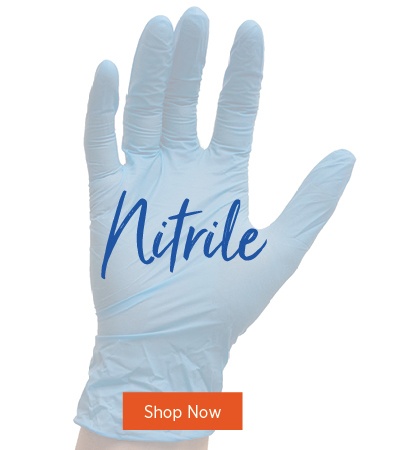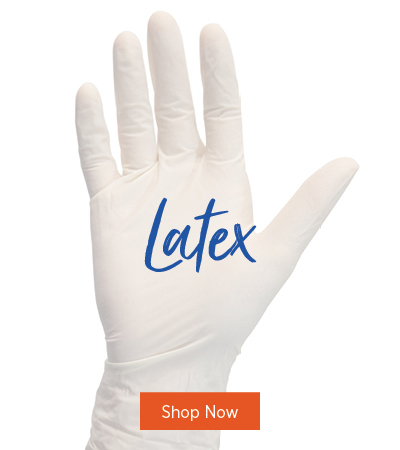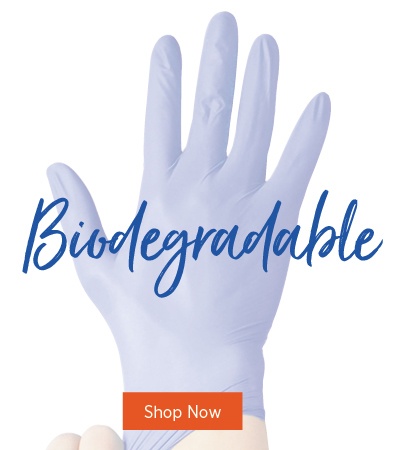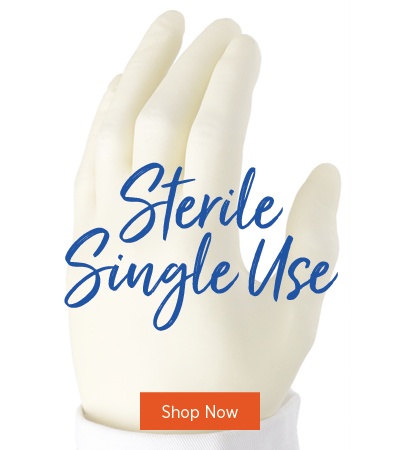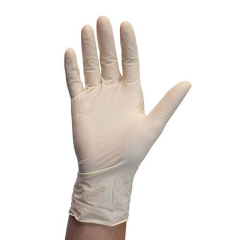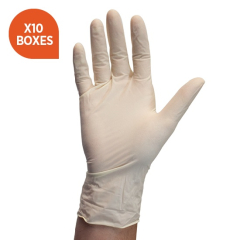Medical Gloves
Available in a wide range of different sizes, colours, materials and thicknesses, we understand that choosing the right type of gloves for you and your practice isn’t always easy.
At Canonbury, we’re proud to stock a wide variety of different glove options to suit your needs, from Nitrile to Latex, Accelerator Free to Sterile.
Whether choosing for specific treatments such as nail surgery or to overcome unwanted allergies, at Canonbury we’re here to help and are dedicated in keeping you and your patients’ safe.
Available for fast despatch, selected ranges of our tried and tested Nitrile and Latex gloves are also available in carton sizes, providing our bestselling, great quality gloves at even greater value.
Below you will find a useful guide, written by Canonbury In-House Podiatrist Michelle Gibson, packed full of expert knowledge and advice on how to choose the right gloves for you.
Shop Bestsellers
Which gloves are best for me? What is the difference?
Latex gloves were the original examination gloves for many years due to their protection from body fluids and bloodborne pathogens; however, people started to develop allergic reactions and sensitivity to rubber, therefore we saw the introduction of nitrile and vinyl options. We also now have accelerator free and even biodegradable gloves. So what is the difference?
Vinyl gloves - are general purpose gloves made from polyvinyl chloride (PVC) – ideal for cleaning and low risk tasks, however they have a loose fit so not ideal if precision is required. They are also not resistant to corrosive chemicals.
Latex gloves – low risk to punctures and tears, likely elastic and flexible for precision actions that are required within Podiatry; however, nitrile have a closer fit. They are made from natural rubber latex which people can be allergic too. Latex gloves should be power free as the powder can also cause an allergic / dermatitis reaction to the practitioner. They tend to be cheaper and lower quality than nitrile gloves.
The Health and Safety Executive (HSE) in the United Kingdom recommends conducting a thorough risk assessment before choosing to use latex gloves in the workplace, especially in health and social care environments. If you choose to use powdered latex gloves then be aware that the powder can cause air particles which act as a carrier to the latex proteins which can be inhaled later causing a risk to sensitivity and potentially an allergy. The HSE recommends using gloves which are low-protein (if not latex-free) and powder-free in applications where Type I or Type IV sensitisation are a risk factor, and has recommended that latex gloves be avoided entirely in hospitals and healthcare roles, if possible (Unigloves, 2022)
Nitrile gloves – have the highest protection against punctures and tears when being worn, therefore, making them ideal to protect the practitioner against bloodborne pathogens. They have the closest fit making them very comfy and sensitive when high precision is required; however if the wrong size is chosen or the hands are still wet when putting the gloves on then they are more likely to split. They are 100% latex free.
Accelerator free gloves – This is a new range of gloves available with the same dexterity for the practitioner as latex and nitrile, however they are produced without the sulfur-based chemical accelerator which can cause a dermatitis / allergy to the practitioner or patient. Why is this chemical used in traditional glove manufacture? It is a stabiliser to allow nitrile gloves to have the flexibility and strength that practitioners require.
|
|
Vinyl | Latex | Nitrile | Accelerator Free | Biodegradable |
|
Description |
Thin, flexible and lightweight. | Elastic and flexible for precision work. | Close fitting with sensitivity, suitable when fine dexterity is needed. | Same as nitrile gloves. | Biodegradable with similar properties to nitrile in use. |
|---|---|---|---|---|---|
| Uses | Cleaning / jobs where there isn’t a need for dexterity. | Healthcare where dexterity is required. | Healthcare where there is a possibility of allergy to latex. | As per nitrile gloves. | As per nitrile gloves. |
| Carton Sizes (Canonbury) | Non-sterile box of 100 |
Non-sterile box of 100 Sterile individual pairs |
Non-sterile box of 100 | Non-sterile box of 100 | Non-sterile box of 100 |
| Sizing - Non-Sterile | Small | Extra Small - Large | Small – Extra Large | Small – Extra Large | Small - Large |
| Sizing - Sterile | 5.5 (Small) – 9 (Large) | ||||
| Advantages |
|
|
As for latex, plus:
|
As for nitrile, plus:
|
As for nitrile, plus:
|
| Disadvantages |
|
|
|
|
|
Gloves FAQs
- Powder was used when gloves were worn in the 1980’s to give an ease of donning the gloves and a feeling of dryness especially, if the hands were damp when originally putting them on. However, people suffered with dermatitis and allergies to the powder. Therefore, the gloves available from Canonbury are now all powder free.
- A thicker gauge glove will provide more protection than a thinner glove of the same material, but often at the expense of touch-sensitivity and dexterity. Double gloving can be used in some cases however this can increase the temperature of the hands, making them more susceptible to sweating and reaction.
- Gloves tend to range from 1.5 mil up to 10 mil. This is the thickness at the fingertips and palm area. Although it should be noted that, depending on the manufacturer, they are not always uniform all the way across. They tend to be thicker at the fingertips than the wrist due to the way gloves are manufactured. The measurement isn’t in millimetres but a gauge and is equal to one-thousandth (0.001) of an inch.
- It is recommended that healthcare workers should wear between 2mil and 5 mil depending on the need for dexterity. All non-sterile gloves sourced by Canonbury will exceed 3mil in thickness.
- Wearing a glove that is too small may make the material become over stretched which can lead to material stress. With the case of latex gloves this could lead to small pin hole perforations that could compromise the safety to the practitioner. With nitrile gloves this could lead to them splitting on application. If the glove is too large, then it could lead to a loss in dexterity. The other reason to make sure your gloves fit in podiatry is that when reducing nails with a nail drill; a glove that is baggy can get caught more easily by the burr leading to a burn on the practitioner’s finger and / or damage to the drill’s hand piece.
- Gloves should be worn when there is a risk of coming into contact with bodily fluids i.e. blood which could expose the practitioner to a bloodborne pathogen. They shouldn’t be worn for routine care i.e. checking pulses, taking blood pressures. When wearing constantly it can increase the risk of dermatitis and sensitivity to the materials within the gloves. Also constantly wearing gloves stops regular hand hygiene – where hand washing is the best control of cross contamination and transmission of pathogens to work surfaces etc.
- Sterile gloves should be worn when needing a glove that is “pathogen” free, e.g. during surgical procedures such as nail surgery. With sterile gloves they are individually packaged and come in sizes from 5.5 to 9, rather than the small, medium, large etc.
- If a nitrile glove comes into contact with Phenol for more than 1 minute then it should be changed due to the corrosive nature of phenol, reaction with the glove and the possibility of leaving the practitioner to exposure and a possible burn (Penn EHRS, 2022).
- Glove box storage wall mounted (see item 104891
104891) for the gloves which are currently open and being used. For all other boxes of gloves, you have within your practice you need to ensure they are kept in a cool, dark place, away from radiators or heat sources. Do not store your gloves in an area where they are exposed to UV light (florescent lighting) / sunlight as they are sensitive to this and can become degraded – causing splitting in nitrile gloves or pin holes in latex gloves.
- Gloves should have the Standard EN455 on the box as well as the CE or CA marking. The EN455 standard was originally written to support the medical devices directive; however there have been several amendments and now also makes reference to the PPE directive. The certification shows the practitioner that the gloves have met a required standard and will offer the PPE protection required against body fluid cross contamination.
- Freedom from holes – this proves that they are an effective barrier to micro-organisms, by checking that there are no pinholes present.
- Testing physical properties – looks at the glove dimensions and physical strength. This varies depending on the material the gloves are made from and the requirements for use i.e in the food industry the gloves may not be required to be as strong as for health care or industry.
- Biological evaluation – looking for potential hazard that may affect the wearer or be transferred to a patient. They include Endotoxins, latex proteins, chemical residues (accelerators) and powder.
- Shelf life – testing to determine the length of time a glove will be fit for use when stored. The maximum shelf life for medical gloves is 5 years from the date of manufacturer (BSI, 2022).
The EN455 standard consists of 4 sections:
References:
Penn Environmental health and radiation safety (2022) Fact sheet Disposable Nitrile Gloves in Chemical labs. Accessed online – Dec 2022. Available from https://ehrs.upenn.edu/health-safety/lab-safety
Gloves.com (2002) Latex glove thickness. Online accessed -Dec 2022. Available from https://www.gloves.com
Gloves.com (2002)Nitrile glove thickness chart. Online accessed -Dec 2022. Available from https://www.gloves.com
Unigloves (2022) Are powdered latex gloves safe to use? Online. Accessed Dec 2022. Available from https://info.unigloves.co.uk
British Standards Institution (2022). Mutli-part document BS EN 455 – medical gloves for single use. https://doi.org/10.3403/BSEN455
What our customers say about us....


